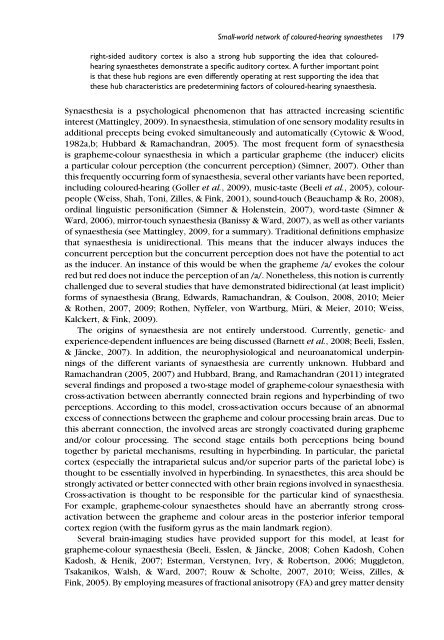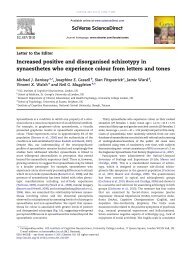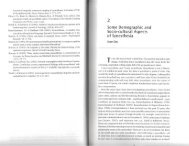A strong parietal hub in the small-world - Synesthesia
A strong parietal hub in the small-world - Synesthesia
A strong parietal hub in the small-world - Synesthesia
Create successful ePaper yourself
Turn your PDF publications into a flip-book with our unique Google optimized e-Paper software.
Small-<strong>world</strong> network of coloured-hear<strong>in</strong>g synaes<strong>the</strong>tes 179<br />
right-sided auditory cortex is also a <strong>strong</strong> <strong>hub</strong> support<strong>in</strong>g <strong>the</strong> idea that colouredhear<strong>in</strong>g<br />
synaes<strong>the</strong>tes demonstrate a specific auditory cortex. A fur<strong>the</strong>r important po<strong>in</strong>t<br />
is that <strong>the</strong>se <strong>hub</strong> regions are even differently operat<strong>in</strong>g at rest support<strong>in</strong>g <strong>the</strong> idea that<br />
<strong>the</strong>se <strong>hub</strong> characteristics are predeterm<strong>in</strong><strong>in</strong>g factors of coloured-hear<strong>in</strong>g synaes<strong>the</strong>sia.<br />
Synaes<strong>the</strong>sia is a psychological phenomenon that has attracted <strong>in</strong>creas<strong>in</strong>g scientific<br />
<strong>in</strong>terest (Matt<strong>in</strong>gley, 2009). In synaes<strong>the</strong>sia, stimulation of one sensory modality results <strong>in</strong><br />
additional precepts be<strong>in</strong>g evoked simultaneously and automatically (Cytowic & Wood,<br />
1982a,b; Hubbard & Ramachandran, 2005). The most frequent form of synaes<strong>the</strong>sia<br />
is grapheme-colour synaes<strong>the</strong>sia <strong>in</strong> which a particular grapheme (<strong>the</strong> <strong>in</strong>ducer) elicits<br />
a particular colour perception (<strong>the</strong> concurrent perception) (Simner, 2007). O<strong>the</strong>r than<br />
this frequently occurr<strong>in</strong>g form of synaes<strong>the</strong>sia, several o<strong>the</strong>r variants have been reported,<br />
<strong>in</strong>clud<strong>in</strong>g coloured-hear<strong>in</strong>g (Goller et al., 2009), music-taste (Beeli et al., 2005), colourpeople<br />
(Weiss, Shah, Toni, Zilles, & F<strong>in</strong>k, 2001), sound-touch (Beauchamp & Ro, 2008),<br />
ord<strong>in</strong>al l<strong>in</strong>guistic personification (Simner & Holenste<strong>in</strong>, 2007), word-taste (Simner &<br />
Ward, 2006), mirror-touch synaes<strong>the</strong>sia (Banissy & Ward, 2007), as well as o<strong>the</strong>r variants<br />
of synaes<strong>the</strong>sia (see Matt<strong>in</strong>gley, 2009, for a summary). Traditional def<strong>in</strong>itions emphasize<br />
that synaes<strong>the</strong>sia is unidirectional. This means that <strong>the</strong> <strong>in</strong>ducer always <strong>in</strong>duces <strong>the</strong><br />
concurrent perception but <strong>the</strong> concurrent perception does not have <strong>the</strong> potential to act<br />
as <strong>the</strong> <strong>in</strong>ducer. An <strong>in</strong>stance of this would be when <strong>the</strong> grapheme /a/ evokes <strong>the</strong> colour<br />
red but red does not <strong>in</strong>duce <strong>the</strong> perception of an /a/. None<strong>the</strong>less, this notion is currently<br />
challenged due to several studies that have demonstrated bidirectional (at least implicit)<br />
forms of synaes<strong>the</strong>sia (Brang, Edwards, Ramachandran, & Coulson, 2008, 2010; Meier<br />
& Ro<strong>the</strong>n, 2007, 2009; Ro<strong>the</strong>n, Nyffeler, von Wartburg, Müri, & Meier, 2010; Weiss,<br />
Kalckert, & F<strong>in</strong>k, 2009).<br />
The orig<strong>in</strong>s of synaes<strong>the</strong>sia are not entirely understood. Currently, genetic- and<br />
experience-dependent <strong>in</strong>fluences are be<strong>in</strong>g discussed (Barnett et al., 2008; Beeli, Esslen,<br />
&Jäncke, 2007). In addition, <strong>the</strong> neurophysiological and neuroanatomical underp<strong>in</strong>n<strong>in</strong>gs<br />
of <strong>the</strong> different variants of synaes<strong>the</strong>sia are currently unknown. Hubbard and<br />
Ramachandran (2005, 2007) and Hubbard, Brang, and Ramachandran (2011) <strong>in</strong>tegrated<br />
several f<strong>in</strong>d<strong>in</strong>gs and proposed a two-stage model of grapheme-colour synaes<strong>the</strong>sia with<br />
cross-activation between aberrantly connected bra<strong>in</strong> regions and hyperb<strong>in</strong>d<strong>in</strong>g of two<br />
perceptions. Accord<strong>in</strong>g to this model, cross-activation occurs because of an abnormal<br />
excess of connections between <strong>the</strong> grapheme and colour process<strong>in</strong>g bra<strong>in</strong> areas. Due to<br />
this aberrant connection, <strong>the</strong> <strong>in</strong>volved areas are <strong>strong</strong>ly coactivated dur<strong>in</strong>g grapheme<br />
and/or colour process<strong>in</strong>g. The second stage entails both perceptions be<strong>in</strong>g bound<br />
toge<strong>the</strong>r by <strong>parietal</strong> mechanisms, result<strong>in</strong>g <strong>in</strong> hyperb<strong>in</strong>d<strong>in</strong>g. In particular, <strong>the</strong> <strong>parietal</strong><br />
cortex (especially <strong>the</strong> <strong>in</strong>tra<strong>parietal</strong> sulcus and/or superior parts of <strong>the</strong> <strong>parietal</strong> lobe) is<br />
thought to be essentially <strong>in</strong>volved <strong>in</strong> hyperb<strong>in</strong>d<strong>in</strong>g. In synaes<strong>the</strong>tes, this area should be<br />
<strong>strong</strong>ly activated or better connected with o<strong>the</strong>r bra<strong>in</strong> regions <strong>in</strong>volved <strong>in</strong> synaes<strong>the</strong>sia.<br />
Cross-activation is thought to be responsible for <strong>the</strong> particular k<strong>in</strong>d of synaes<strong>the</strong>sia.<br />
For example, grapheme-colour synaes<strong>the</strong>tes should have an aberrantly <strong>strong</strong> crossactivation<br />
between <strong>the</strong> grapheme and colour areas <strong>in</strong> <strong>the</strong> posterior <strong>in</strong>ferior temporal<br />
cortex region (with <strong>the</strong> fusiform gyrus as <strong>the</strong> ma<strong>in</strong> landmark region).<br />
Several bra<strong>in</strong>-imag<strong>in</strong>g studies have provided support for this model, at least for<br />
grapheme-colour synaes<strong>the</strong>sia (Beeli, Esslen, & Jäncke, 2008; Cohen Kadosh, Cohen<br />
Kadosh, & Henik, 2007; Esterman, Verstynen, Ivry, & Robertson, 2006; Muggleton,<br />
Tsakanikos, Walsh, & Ward, 2007; Rouw & Scholte, 2007, 2010; Weiss, Zilles, &<br />
F<strong>in</strong>k, 2005). By employ<strong>in</strong>g measures of fractional anisotropy (FA) and grey matter density




